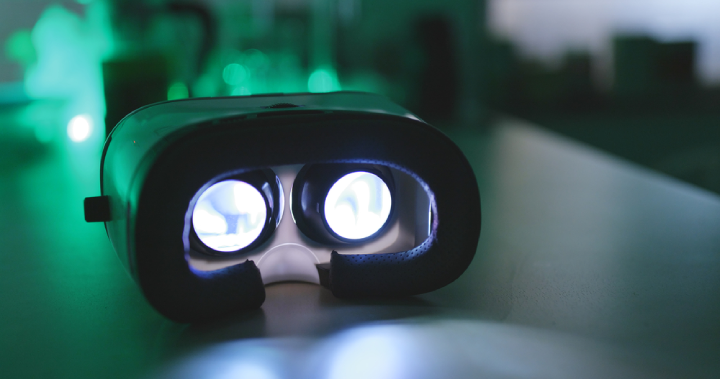
Virtual reality and mixed reality experiences have become more popular in recent years. In particular, the interest in the metaverse boomed in 2021, when Mark Zuckerberg’s Meta heavily invested in Reality Labs and similar technologies.
Even if the current statistics of interest in the metaverse have dropped, as proven by Google Trends figures, certain companies are still in the business and are actively programming and creating new virtual reality headsets to suit both businesses’ and gamers’ needs.

Some projects, like Samsung’s Gear VR and Google’s Glasses, have been discontinued, but other big companies like Apple and HP have augmented reality products in stock. With prices ranging from $500 to $3,500, these are some of the VR headsets still purchasable on the market.
Apple
Apple has recently announced their first virtual and augmented reality headset. Apple Vision Pro was indeed announced during the latest WWDC developer conference, describing it as a “profound technology”. Tim Cook, Apple’s CEO, said that it was “a new type of computer that blends the virtual world with the real world”. Currently, its release date will fall at the beginning of 2024 and its retail price stands at around $3,500.
Vision Pro works through hand gestures, eye movements and voice commands. Its aesthetic is typical of Apple products, with a sleek design and neutral colours, made of aluminium like the Apple Watch. Its battery, with only a two-hour life, is separate from the main frame so that it is not too heavy to wear on the head.
The main aim of Vision Pro is to become a new tool for work, both remote and office-based, thanks to its virtual FaceTime features and the possibility of working on multiple documents at once. Since there is no secondary camera for video conferencing, Vision Pro creates a virtual avatar based on your real facial features that will show up on the other participants’ screens.
The VR headset runs on an M2 Apple Silicon chip alongside the new R1 chip, which is useful for real-time sensor processing which, ultimately, can help against the claustrophobic feeling and nausea that one might experience when using a headset. In addition, Apple created a new operating system for this VR project, VisionOS, which is a conglomerate of all other frameworks used on different devices.
Microsoft
Microsoft also joined the VR headset club in March 2016, when it released HoloLens Development Edition. This specific version was dedicated to experts and hobbyists in the US and Canada, who could buy it for $3,000 to participate in the pre-production of the official version of it.
In October 2016, HoloLens was made public and available in Australia, Germany, New Zealand, France and the UK. Alongside the basic version, there was also the Commercial Suite, to better reflect the needs of corporations and enterprises with new extra features like BitLocker security, for $5,000. In 2019, during the Mobile World Congress (MWC), Microsoft announced the HoloLens 2, starting at $3,500.
Microsoft’s HoloLens is a first-generation AR headset, and its technology is best suited for the fields of engineering, construction, healthcare and education. This is why companies like the NHS and Audi have invested in HoloLens 2. All the available apps are backed up on the Microsoft Cloud.
Samsung
Gear VR is the name of Samsung’s own virtual reality headset. Launched in 2015, it is a collaborative project between Samsung and Oculus.
It is different compared to both Microsoft’s and Apple’s headsets as the display, in this case, is the screen of a compatible Samsung Galaxy phone rather than being included in the structure. At the beginning, in the first 2014 release, only the headset was only compatible with the Samsung Galaxy Note 4. However, with the new SM-R322 version in 2015, the SM-R323 in 2016, and the SM-R324 and 25 in 2017, Samsung expanded the reach of the headset to more mobile phones.
The phone can be connected by a USB-C or micro-USB, and it is controllable via the VR headset itself, which expands the field of view and adds a custom inertial measurement unit (IMU) for rotational tracking.
The idea behind a VR headset originally came in 2005, when Samsung bought a patent on a head-mounted display which used a mobile phone as the screen. Due to the limited technological advancements of the time, the company kept it under work until 2013, when work resumed and prototypes were built. When Samsung collaborated with Oculus in 2014 to release the Oculus Rift, another VR tool, Samsung also announced the Gear VR. However, Samsung announced in 2020 that it would discontinue the Gear VR headset.
Meta
After announcing the Quest 2 VR game console in 2020, Meta released its new VR headset project: Meta Quest Pro. Starting at $1,499, the device comes following Mark Zuckerberg’s metaverse immersion.
The purpose behind this headset, similarly to Apple’s, is to make office and creative work easier and more involving. The Quest Pro runs on Microsoft software and it is sold by Accenture, with gaze and eye tracking functions and 10 cameras.
When using the Meta Quest Pro, the user can choose a setting out of 14, including a Lord of the Rings-themes room and a pink yoga studio to enlighten the atmosphere while working. The sleek and solid main frame, made of glass and black plastic, is accompanied by a charging cable, removable magnetic gaskets, a protective headset cover and a microfiber square, alongside other accessories.
In the first week of June 2023, Zuckerberg and Meta’s team announced the next-generation VR headset Quest 3, which is a further evolution of Quest 2. The new model will come in the autumn, and it features higher resolution, better and quicker performance, and a new technology developed by Reality Labs. It will be the first VR headset featuring the Snapdragon chipset developed alongside Qualcomm Technologies to drastically improve graphics and substitute the previous Snapdragon GPU used in Quest 2.
Contrary to Quest Pro, Quest 3 is more focused on gaming and entertainment rather than working programs. Over 500 VR games, apps and experiences will be available to Quest users, who will be able to have an immersive gaming experience.
HP
HP produced a wired PC VR headset, the Reverb G2, in 2020. At a starting price of $599, it has sharp and smooth graphics at a 90Hz refresh rate, with a 114-degree field of view.
Unlike other Windows Mixed Reality headsets, the HP Reverb G2 includes four sensors to deliver more accurate VR tracking, perfect for fast-paced games and visuals. It also includes two motion controllers, which can be updated to Valve’s finger-tracking controllers.
HP also put a lot of emphasis on enterprise clients, not only gamers. Spike Huang, HP vice president and global lead of VR said in a statement: “The power of collaboration is on full display with the HP Reverb G2, and alongside Valve and Microsoft, we engineered a no-compromise VR headset that’s immersive, comfortable, and compatible across Windows Mixed Reality and SteamVR.”
HTC
One of the most popular VR headsets on the market is HTC’s Vive Pro 2, even if it is slightly pricier than HP’s, retailing at $1,399 if including the wand controllers. However, if the headset is bought separately to step-up from the original Vive Pro or the Valve Index, it costs $800.
This headset features a 5K screen and a 120Hz refresh rate, a big upgrade from the first Vive Pro, which had a 90Hz refresh rate and a 4K screen resolution.
HTC Vive was produced in collaboration with Valve, including its SteamVR hardware and software. Even if announced in 2015, the first Vive model was available for purchase in 2016 and, since then, it has gone through various versions and developments. In particular, 2018 saw the company release the first Vive Pro, Vive Pro 2’s predecessor, which quickly became HTC’s high-end VR product. In 2019, Vive Pro Eye was announced too, adding built-in eye-tracking systems. Finally, in 2021, the corporation unveiled Vive Pro 2.
When it comes to enterprise focus, Vive Focus is another VR headset produced by HTC. As it does not require a computer to function, it gives more freedom to work remotely. Vive Focus Plus and Vive Focus 3 were then introduced respectively in 2019 and 2021, with improved resolution and comfort.
HTC has experimented vastly with VR headsets, also introducing Vive Cosmos in 2019 with inside-out tracking and a different controller compared to the Focus’. This particular model is indicated for both gaming and enterprises, alongside its variations Cosmos Elite, Cosmos XR with enhanced mixed reality experiences and Cosmos Play, better suited for beginners.
After releasing the Vive Flow in 2021, which is a standalone headset characterised by a visor which resembles glasses and powered by the Qualcomm Snapdragon XR1 system-on-chip, the most recent announcement from HTP was the Vive XR Elite, in January 2023. The latter is very similar to the Meta Quest Pro and, like its predecessor, it is shaped like goggles.






